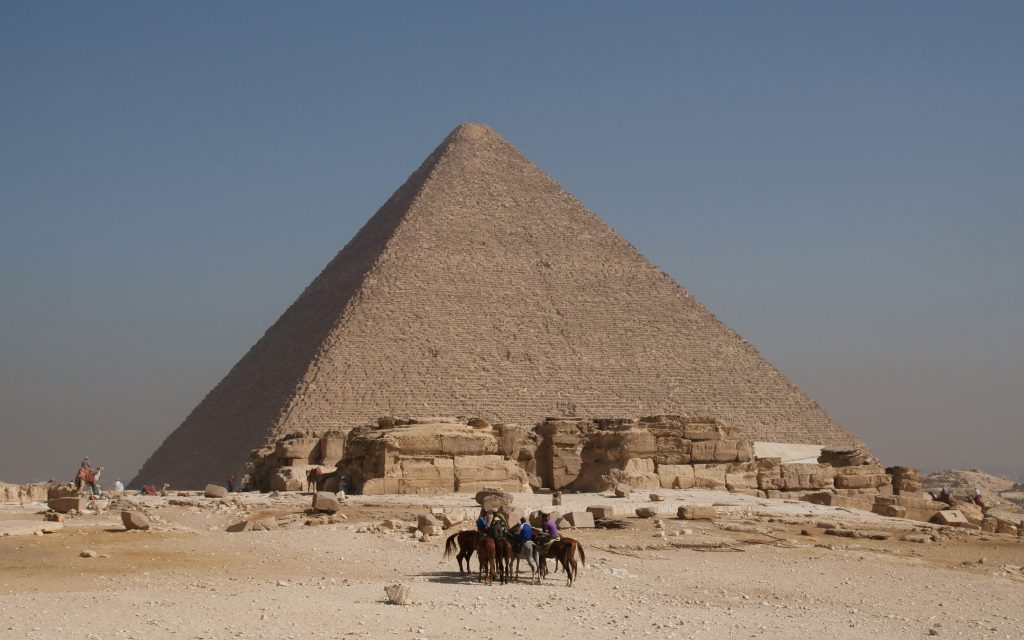The construction of the Great Pyramid of Giza has been a great mystery for many centuries. Recently, archaeologists believe that they have found evidence that suggests that it was not slaves, under the order of King Khufu, who were responsible for building the pyramid. With the discovery of nearby mastabas, there is now substantial evidence suggesting that normal villagers would periodically help construct the Great Pyramid, and they were motivated by their religious beliefs.1
King Khufu is considered one of the greatest rulers of his time, largely due to the elaborate pyramid he was able to create during his lifetime. He was known as a cruel and tyrannical leader, but was evidently powerful by being able to gather a large workforce and enough materials to construct the Great Pyramid, most of which is still intact today. According to Greek historian Herodotus, there had been around one hundred thousand slaves working through King Khufu’s reign. This was proved false in 1990 when the archaeologist Zahi Hawass discovered a town of mastabas near Giza.

These mastabas were rectangular mounds made of mud bricks. Eventually, they would stack some of them together to form pyramids, giving them the idea of the modern pyramid. The findings of many mastabas suggests that the workers were not slaves but were actually compensated in some form for their labor. They also discovered two miniature pyramids that held the remains of officials, such as supervisors, technicians, and craftsmen on the upper level, and other laborers on the lower level.2 The workforce consisted mainly of peasant farmers who would work during the fall and winter seasons. During that time period they were unable to work on their farms due to the seasonal overflow of the Nile River. This gave them an opportunity to continue working throughout the year. It was also a great way for the peasant farmers to get food, clothing, and shelter.3 Some laborers took part in a group called a phyle, which was a rotating group of workers who would work for a month. The king would collect surplus crops as well as other clothing to distribute to these workers, which he levied as a form of tax. Egyptologist such as Zahi Hawass and Mark Lehner now estimate that only about twenty to thirty thousand men were needed to build the Great Pyramid.
The construction of the pyramid was a communal project in which all Egyptians took part, including women as well as men. At the time, there were no machines or animals to help carry the loads of limestone and granite to the pyramids.4 Every block was handmade and crafted to fit perfectly alongside the other pieces. They cared greatly in their work and took pride in their accomplishments. Not only were they building the burial site for their king, but they were also taking part in the construction of a new and elaborate Egypt.
During Egypt’s Old Kingdom, when these pyramids were built, the kings were associated religiously to gods. They were seen as the living manifestation of the god Horus, the god of the sky. The god Horus was also the son of Osiris, who was the king of the underworld. Once the king would pass away he would become one with Horus.5 This helped motivate the laborers to continue building the pyramids. Most Egyptians at that time were very religious and spent their life preparing for what would come after death. They believed that by building the pyramid for their king, a descendant of Osiris, they would assure both their king and themselves a good afterlife. Because of this, they did not see their work as a continuous strain, but rather viewed it as an honor.
Overall, it was a very organized and coherent system that allowed everyone to partake in. It was beneficial not only to King Khufu, but to the entire Egyptian society as well. Jobs were created and many peasants received benefits of clothing and shelter from the enterprise. It united the Egyptian civilization and created magnificent pyramids that we can still visit today.
- Mastabas are burial mounds that were used to bury rulers and pharaohs, which later gave way to the idea of a pyramid. See Global Events : Milestone Events throughout History, Vol 1. Africa, Jennifer Stock, ed. (Detroit : Gale, Cengage Learning, 2014., 2014), 12. ↵
- Global Events : Milestone Events throughout History, Vol 1. Africa, Jennifer Stock, ed. (Detroit : Gale, Cengage Learning, 2014., 2014), 18. ↵
- The Oxford Companion to Archaeology (2 ed.), 2012, s.v. “Pyramids of Giza,” by Edward Bleiberg. ↵
- The Oxford Companion to Archaeology (2 ed.), 2012, s.v. “Pyramids of Giza,” by Edward Bleiberg. ↵
- Funk & Wagnalls New World Encyclopedia, 2016, s.v. “Horus”. ↵



87 comments
Madison Downing
This article was short and sweet but I loved it even more for that! You totally got your point across without having to elaborate or do a mistake a lot of writers do and start repeating themselves. I think I find it incredibly amazing on the idea that the reasons the great pyramids of Egypt are still standing is because it wasn’t slave work that was put into them (there might have been some) but it was the love for the civilians king that made them complete a task for a 100,000 men with only between 20,000-30,000 men AND women. It’s so crazy that these wonders of the Earth were completed within King Khufu’s life, he was able to see it first hand once it was completed. I wish I could have admired the view with him and see how they looked back then.
Stephanie Silvola
I am in love with Egypt, pharaohs, and Egyptian gods. The pyramids are really fascinating to me because the structure is so complex that building something great like a pyramid is a great accomplishment. There are a lot of theories as to how the pyramids were built, if the Egyptians really built it or if another region did, or if the human race really did do it. No matter how it is built, it will serve as a gift for the pharaohs to come. The pyramids created a society and couldn’t have been a greater gift for the gods.
John Berka
The pyramids of Egypt are some of the most famous and awe-inspiring relics of the ancient world. I had bought into the long standing rumor that it was slave labor that built the pyramids, and now this revelation that it was normal villagers working on them during the seasons when they don’t have their normal jobs really makes a lot more sense. These villagers truly believed in the significance of these pyramids, and they were honored and duty bound to work on these pyramids to ensure their leaders had a good transition to the afterlife.
William Ward
It is very interesting to read about how the generations before us, without the help of fancy technology, built such magnificent structures that have lasted longer than most of which was created at a similar time. Only one point comes up in the descriptive article that I feel should definitely stand as a legitimate creator of the Pyramids. Could it be aliens? Yes? No? Maybe?
Faten Al Shaibi
There is no doubt that the pyramids are of the great relics that exist to the present day, and is one of the seven wonders of the world for the accuracy of its manufacture.
How great is the work of archaeologists to learn more about the construction of the pyramids.
The vision of the pyramids shows the greatness and strength of the people who built it.
Daniela Cardona
I have always been so curious as to how the pyramids were built. You hear a lot of conspiracies about how the most probable way was aliens. Although it sounds foolish, I have heard a lot of evidence that makes it seem moderately believable. Reading this article, however supplied me with a lot of way more believable knowledge that really explained the phenomena more. It makes perfect sense for there to have bee a whole village of people who built the pyramid, especially when you think about the fact it was for the king and almost in fear of the Gods as well. It is still hard to believe in some ways though like the fact that they would have had to form every brick by hand. It does not seem feasible in any life span, or really at all considering how large the pyramids are.
Michael Hinojosa
This article is really eye opening since I didn’t know that humans were capable of such amazing feats back then when they didn’t even have the modern tech that we use now! It’s also interesting to know that the pyramids were built by hand and not through the use of aliens that a lot of people seem to believe so.
Luis Magana
It’s amazing how something like that could have been built by men and women without any machines. they are enormous. How were they able to build something so big and heavy by hand in just 20 years? Many people think slaves built the pyramids because that is the way it has always been depicted. It makes sense that the local loyal people would build the pyramids and they would be recomposited.
Alexander Manibusan
So these mastabas were used to build the pyramids or were they just used as some sort of inspiration? That’s very interesting though- to see both men and women work on such a lofty project. And the fact that the pyramid of Giza is still standing, after more than several thousand years is even more incredible. I also still find hard to believe that it took about 20,000 to 30,000 people to build it, rather than Herodotus’ estimate of 100,000.
Maria Esquivel
This article is very interesting and provides great details of the construction and meaning of the Pyramid of Giza. I could not believe the loads of granite and limestone were carried by the people, I found that very interesting. If you see images of these pyramids they are absolutely beautiful, but reading how they were crafted makes them even more astonishing. It’s incredible how humans made something so enthralling.